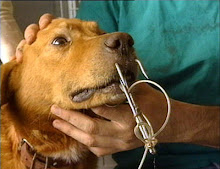Did you know that there were about a thousand pets that died?
With a recall of one hundred and fifty different brands being recalled the FDA had received more then eighteen thousand calls. That was the most calls they have ever received on any recall.
I guess that just shows you the concern that we have for are pets. Did you know that there were other recalls back in two thousand and four and two thousand and six.
Here is a link to a public meeting with the FDA, I hope they all get there heads together and put a stop to these foreign countries that will ship anything to our county to make a buck.
Here is a little of what is being said:
The commercial pet food industry faces minimal substantive regulation, despite navigating several layers of regulation from various groups including the FDA, the American Association of Feed Control Officials (AAFCO), and state regulators. The FDA entrusts AAFCO to issue regulations governing ingredients, feeding trials, labels and nutritional claims. But AAFCO’s rules fall short of ensuring that America’s pets receive adequate nutrition, or even foods that won’t cause chronic digestive, skin, eye, and coat problems.
• Trusting, but uneducated, consumers purchase these commercial pet foods under the assumption that the FDA or some other regulatory body has ensured that the foods contain “balanced” meals, and “complete” nutrition. These consumers naively believe veterinarians that endorse and sell pet foods from their offices while neglecting to mention that these “pet doctors” are often “on the take” and can earn up to 20% of their total income from such sales.
• Interestingly, CVM “has used regulatory discretion and not required food additive petitions for substances that do not raise any safety concerns.”
• One has to wonder how closely the CVM monitors the “intended use” of the additive considering they have already chosen not to use their resources for pre-market approval as mandated by Congress in the FFDCA. Moreover, it is unclear from where the CVM expects to “receive” data that calls into question the “safety” of the additive. Certainly, it will not be provided by the pet food manufacturer.
• The omission of a request for proof that the food has undergone testing for effectiveness is striking.
• It is important for pet owners to recognize that the FDA has made a choice: to focus its attention on human foods, and leave the pet foods to someone else.
• Today, AAFCO claims that protecting the consumer remains its primary goal. Yet by falling under the overwhelming influence of the $13 billion pet food industry, AAFCO turns a blind eye to dangerous ingredients and the vagaries of the manufacturing process in general.
• AAFCO has no enforcement authority and does not perform any analytical testing on pet food. A pet food manufacturer is only required to comply with the pet food regulations of the state in which it manufactures or sells its products.
• But AAFCO does not determine permissible sources of protein or other essential nutrients – AAFCO’s only requirement is that the manufacturer comply with AAFCO’s extensive list of ingredient definitions.
• The nutrient profile method does not test nutrient bioavailability in the same way as the “feeding test” method. Nor does it test the palatability of the foods. In contrast, the “feeding test” method doesn’t always test the actual product sold. Because of the AAFCO “family member” rule, products that are nutritionally similar to other products tested under the “feeding test” method do not need to be tested themselves. Since these family member products aren’t directly tested, they suffer the same problems as those undergoing the nutrient profile method: uncertain nutrient bioavailability and palatability.
• One has to wonder, if PFI is serving as the voice of the industry, who is serving as the voice of the consumer?
• If the CVM will not, or cannot, fulfill its responsibilities regarding pet food and if AAFCO continues to lack enforcement power, then the industry has no one to fear except the consumer. Unfortunately for pets, the industry has proven effective at confusing their owners to the point of insuring that few consumers possess the information necessary to challenge the industry’s shoddy practices.
• Only about 50% of every food producing animal is used in human foods. All components not ingested by humans (bones, blood, intestines, lungs, ligaments etc.) are used in pet foods, animal feed, and other products.
• Unfortunately, also included in these “other parts” are the so-called 4D tissues, or “meat that came from animals that were dead, dying, diseased or disabled before they reached the packing plant.” Such animals are rejected for human consumption and shipped to rendering plants where they are made into bone and meat meals. More importantly, the inclusion of such tissues in pet foods violates the FFDCA. Such items are diseased and therefore “adulterated” under 21 U.S.C. § 342. So why doesn’t the FDA bring an enforcement action for the industry’s blatant violation of the FFDCA? Most likely, the pet food industry uses such ingredients because they are cheap and while consumers remain oblivious to the inclusion of these diseased ingredients into their pets’ foods, the industry faces no opposition. Until the FDA feels external pressure, either from consumers or the industry itself, the FDA lacks incentive to enforce its own regulations. Comparatively, the FDA stringently enforces its human food regulations where it faces informed and vocal consumers and industries fearful of negative publicity.
• Basically, rendering separates the fat soluble ingredients from water soluble and solid materials. The process kills most bacterial contaminants, but the valuable natural enzymes and proteins contained in the raw materials are also destroyed or altered.
• Cancerous tissue, tumors, contaminated blood, injection sites and any tissues treated with a substance not permitted by or in excess of FDA or EPA limits is also rendered. The inclusion of such items in pet food violates the FDA’s requirement regarding unadulterated food. Recall that foods containing “any part of a diseased animal” is deemed adulterated. With an understanding of the rendering process and its ingredients, it is then unclear how AAFCO (and thereby the FDA) approves ingredients such as meat and bone meal for use in pet foods.
• It is difficult to see how the FDA can continue to allow AAFCO and the pet food industry to self-regulate when they encourage pet owners to buy their products because most of the disease causing agents are dead. Shouldn’t the standard at least be a food that contains no agents of disease? If they’re not going to sell the most nutritious product, it would be nice if they adhered to consistent quality control regulations that protected our pets from disease.
• Labeling rules require that the ingredients be listed in descending order of predominance by weight (not overall % dry matter content) so that the heaviest ingredient, determined before the ingredient is cooked or processed, is listed first. This means that even if a label lists “chicken” first and “corn” second, it is possible that the product contains far more corn than chicken. This is because chicken is very high in moisture (75% water) and therefore heavier than corn. Thus, despite all the labeling rules, the average consumer has no idea how much chicken serves as the main protein source for the product.
• The rise in the use of grain and carbohydrate products over the last decade further contributes to the nutritional imbalance in commercial pet foods. “Once considered a filler by the pet food industry, cereal and grain products now replace a considerable proportion of the meat that was used in the first commercial pet foods.” Why the change? Cost. Corn is a much cheaper energy source than meat. But the change in pet food formulas has a real impact on a pet’s health. “Dogs have little evolved need for carbohydrates and cats have no need for this source of energy.”
• Most pet owners select one pet food and feed it to their pets for a prolonged period of time, if not for the pet’s entire life. This means the pet is eating a diet consisting primarily of carbohydrates (some of which they can’t digest) with little to no variety. “[U]ndigested food arriving in the bowel provides nutrients for a teeming population of harmful bacteria.” Thus, “chronic digestive problems, such as chronic diarrhea, and inflammatory bowel disease” often result from such repetitive and indigestible diets.
• Feeding low-quality commercial pet foods for a pet’s entire life is comparable to feeding a child McDonald’s three meals a day, every day, for the child’s entire life. No parent would believe that this is a nutritious diet, or capable of sustaining a child’s health. Yet regulatory choices made by FDA, CVM, and AAFCO, combined with efforts by the pet food industry to avoid stringent ingredient and processing regulations result in pet owners unknowingly feeding junk food to their furry friends.
• As Dr. Wysong points out, this “food could cause disease and destroy long term health, yet not be harmful and be 100% complete” because it managed to sustain a dog for 6 months. Shouldn’t the sustainability goal of the pet food industry be much longer than 6 months?
• The most honest solution would be to cease the “complete and balanced” claims and start to educate the consumers about nutrition and their pets’ specific needs.
• There are virtually no long term studies showing the adequacies and inadequacies of the nutrient profiles. One of AAFCO’s own panel experts admits that some of the foods which pass the feeding trials are “inadequate for long term nutrition.” Current regulations provide no way of knowing which foods can potentially harm pets in the long run.
• Additionally, commercial pet food labels are nothing if not cryptic. One FDA veterinary nutritionist says it takes him three hours to explain pet food labels to veterinary students. These are veterinary students who have gone through years of science classes and education. Imagine how long it would take to explain a label to the average pet owner to the point that they would be capable of comparing products and making a sound decision concerning their pet’s health.
• AAFCO regulations also require that labels not contain graphics or pictorial representations that misrepresent the package’s contents. Yet manufacturers violate this regulation every time they place a plump chicken on their box or bag of food. The pet food industry’s continued use of rendered products ensures that no plump chickens make their way into the commercial pet foods. Until such violations are identified and the manufacturers sanctioned, the pet food industry remains one of the most misleading.
Meanwhile, virtually every article or website dedicated to discussing commercial pet foods concludes with the standard blanket statement telling the consumer to consult their veterinarian. While it may be true that the veterinarian is more educated than the consumer, the section above details why trusting a vet with 100% of your pet’s care is as fallible as trusting complete and balanced labels on pet foods. The better conclusion to these articles is a call to action for consumers to educate themselves and persuade their vets to work with them in creating a diet suitable for their pet’s nutritional needs.
Read the full report.
Read the comment sent in by Michael R. Floyd The Founder of www.defendourpets.org
Read the article by Sophie L. Rovner who put together a great article about the pet food recall.
Tuesday, May 13, 2008
Subscribe to:
Post Comments (Atom)




No comments:
Post a Comment